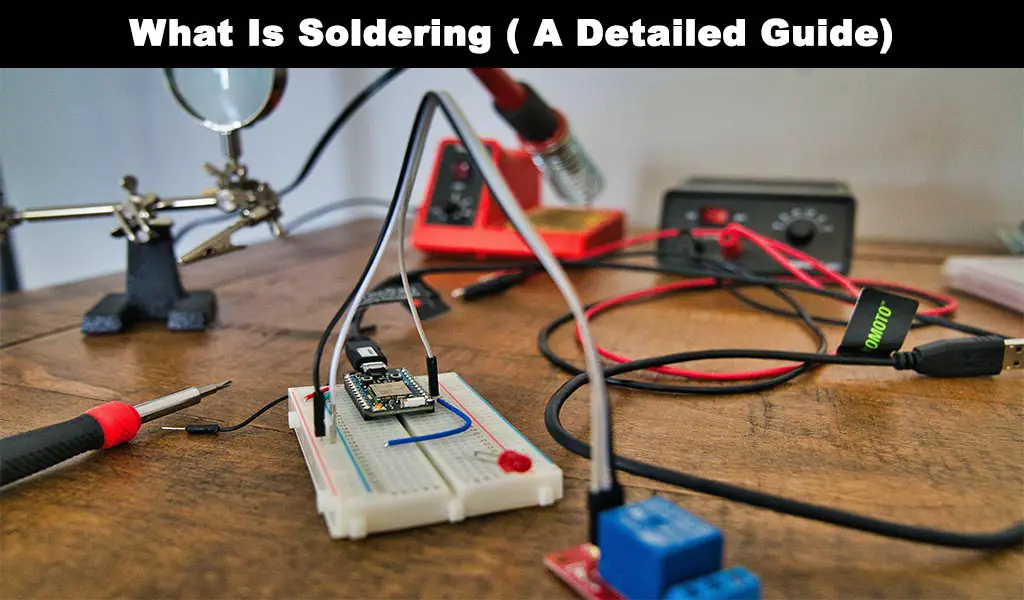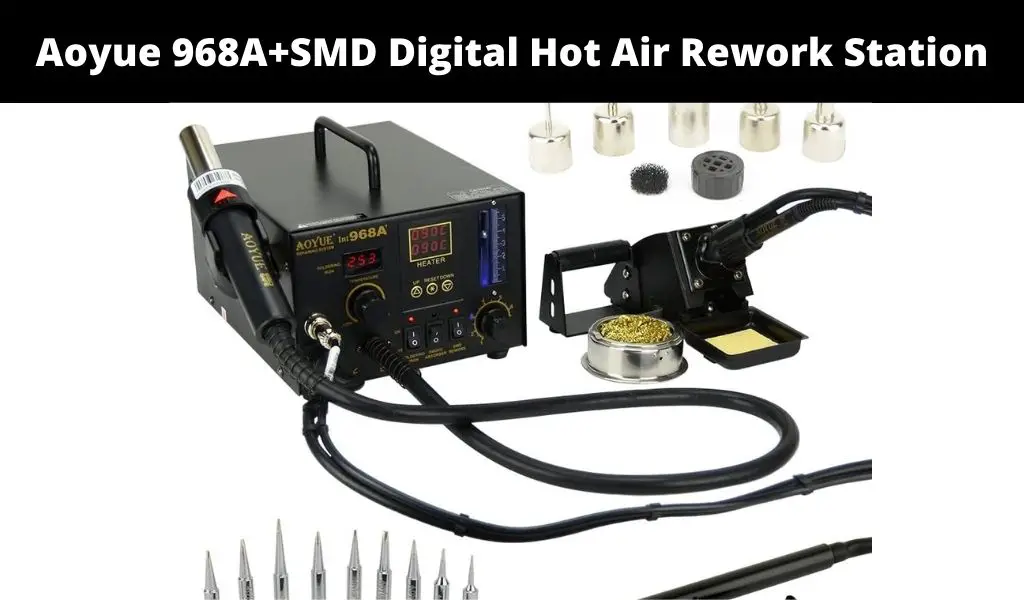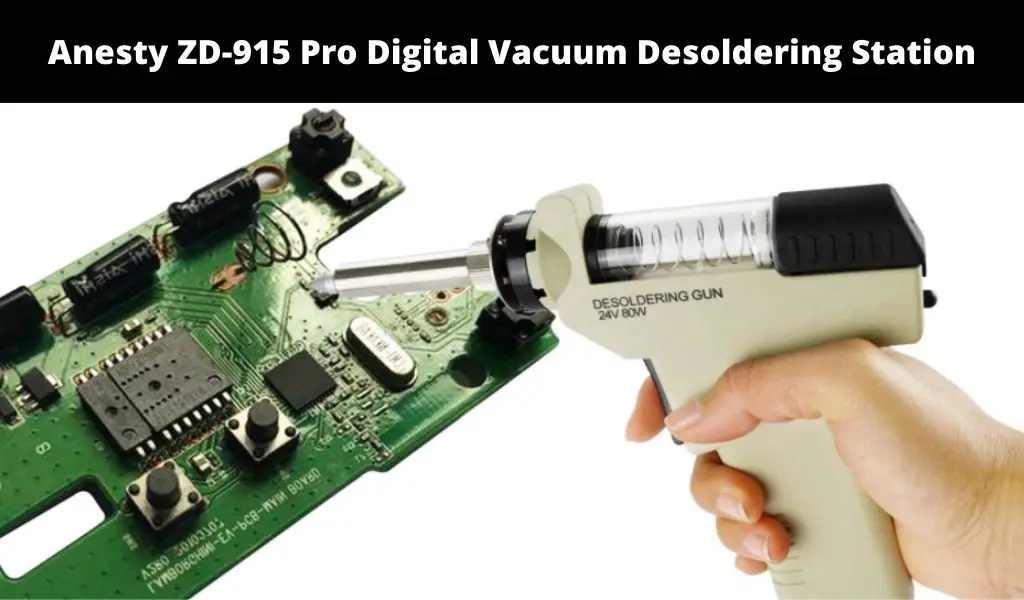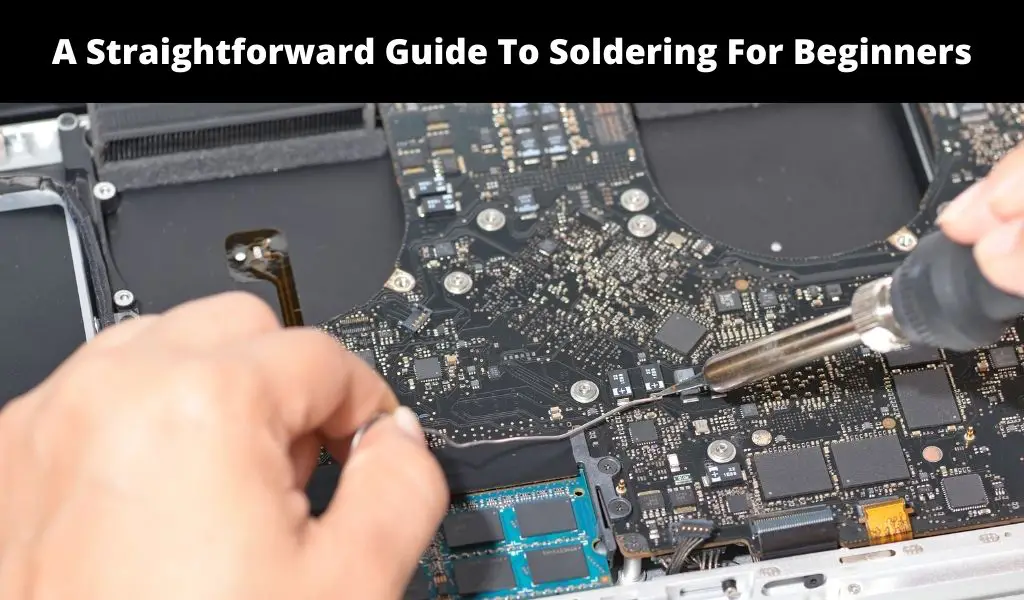The guide below will cover all there is to know about soldering, from the definition to brief history, applications, types, and other important information.
What Is Soldering?
Soldering is a term used to describe the process of joining two metals together by melting a metal alloy (solder) composed of lead and tin or other materials. The solder is melted using a very hot rod at temperatures exceeding 600 degrees Fahrenheit.
For more specifics on soldering, let’s begin by describing how the process works, brief history, and then answer many common questions about soldering.
How Does Soldering Work?
When soldering, solder is melted at around 600 degrees Fahrenheit. The solder is heated using an iron rod connected to a heating source. After cooling, it forms a soldered joint between the metals being joined together.
Soldering creates strong electrical joints. The solder (a metal alloy) creates strong bonds between metals like copper when joining copper pipe joints and circuit boards together. Depending on the application, the type and diameter of solder will vary.
Some solders contain lead, while others are lead-free. Lead-based solder has been replaced by lead-free varieties that contain tin, silver, brass, bismuth, copper, indium, or antimony. Solder contains a core made up of a material known as flux that improves the mechanical properties of the solder.
Brief History of Soldering
Soldering dates back centuries. The earliest evidence of soldering can be traced back to Mesopotamia over 5,000 years ago. Historically, cookware and jewelry were made using soldering techniques.
Types of Soldering
Soldering can be categorized in several ways. When categorized based on temperature, there are 2 main types namely, soft soldering and hard soldering.
I. Soft Soldering
This type uses temperature levels between 90 and 450 degrees Celsius. It utilizes filler metals with the lowest melting point. The filler metals tend to be alloys whose liquidus temperature ranges below 350 degrees Celsius.
Since soft soldering utilizes low temperatures, it doesn’t result in very strong joints making it ideal only for applications that don’t involve mechanical load-bearing.
II. Hard Soldering
This type utilizes higher temperatures (above 450 degrees Celsius). In hard soldering, the bonding metal is usually silver or brass. Hard soldering requires a blowtorch to reach temperatures above 450 degrees Celsius.
Soldering can also be categorized based on the technique. In this regard, there are several types discussed below;
III. Laser Soldering
In laser soldering, a 30 to 50w laser is used for melting and soldering electrical connection joints. The technique uses diode laser systems. Laser soldering dates back to 1980. The technique was patented by Suzanne Jenniches.
Laser wavelengths range from 808 to 980 nm, and beams are delivered via optical fiber to a workpiece with a fiber diameter of 800 m or less.
To control beam divergence from the fiber, lenses are used for creating an appropriate spot size on a workpiece at suitable working distances. When laser soldering, solder is supplied using a wire feeder.
The technique solders silver-tin and lead-tin. The exact soldering process differs based on alloy composition. When soldering, the appropriate power level and solder time is used. Low power levels result in incomplete wetting. Voids are also bound to form, weakening the resulting joint.
IV. Induction Soldering
This type of soldering utilizes induction heating via high-frequency AC (alternating current) surrounding a copper coil. Induced current forms the part being soldered and generates heat due to higher resistance of the joint vs. the surrounding metal. The shape of copper coils can be adjusted accordingly to match the joint.
The solder (filler metal) is placed in between facing surfaces. What’s more, the solder melts at low temperatures. Induction soldering utilizes fluxes in many instances. The technique is common in continuous soldering applications where coils wrap around cylinders or pipes being soldered.
V: Fiber Focus Infrared Soldering
As the name suggests, this soldering technique is characterized by fibers leading multiple infrared sources. The fibers focus on one spot where a connection is soldered.
VI: Resistance Soldering
In resistance soldering, current is conducted via resistive material to produce a specific level of heat. This soldering technique needs heat for flowing the solder. As a result, electricity is passed via the solder. The resulting heat is predetermined or controlled by regulating the current conducted as well as resulting resistance.
Electrical resistance transforms electricity into thermal energy as current passes through material with resistance and releases power. Resistance soldering is different from using condition iron, where heat is generated within an element before being passed through thermally conductive tips into a joint area.
Cold soldering iron needs time to achieve working temperature. The iron should also maintain hotness between solder joints. To ensure thermal transfer, the tip should be wetted properly.
It is possible to have intense and direct heat within a joint in a controlled manner to allow a quick move to the required temperature. This also reduces thermal travel from a solder joint, reducing thermal damage risks on surrounding components or materials.
Resistance soldering is a more energy-efficient soldering technique since heat is generated on demand (when a joint is made). The technique is common for difficult soldering as well as brazing where high temperatures are required.
Resistance soldering can compare to other techniques like flame soldering. The desired temperature can be reached via flame or through resistance methods.
VII. Active Soldering
This technique is simply flux-less soldering using a conventional soldering iron or a specialized soldering pot with an active solder containing active elements like chromium, titanium, or zirconium. Active elements react with a surface generally known to be hard to solder in the absence of premetallization.
Active solders are safe from oxidation because of additional rare-earth elements like cerium and lanthanum with a high oxygen affinity. Other common additives include gallium. For active soldering, mechanical activation is needed.
It can be done by brushing (using a stainless wire brush) or through ultrasonic vibration (at 20 to 60kHz). Active soldering is common in ceramic bonding as well as bonding titanium, silicon, aluminum, carbon, and graphite-based structures. The technique requires temperatures below 450 degrees Celsius. Alternatively, a protective atmosphere is needed.
Soldering Tools
Soldering requires special tools. Luckily, you just need one tool to solder successfully. There are two main types of soldering tools namely;
A. Soldering Iron
This is the most common soldering tool known today. A soldering tool is merely a hand tool plugged into standard 120-volt power outlets. The iron heats up to a temperature where it can melt solder. The tool is common in soldering applications that involve creation of electrical connection.
While there are several variations of soldering iron tools i.e., soldering iron guns and soldering iron pens, they work via the same principles. Beginners should use pens in the 15-30W range. While pens and guns are the most common, soldering iron tools have interchangeable tips used for varying applications.
It’s worth noting that a soldering iron comes with some risks. Since they heat up to extreme temperatures (up to 896 degrees Fahrenheit), they need to be used cautiously.
B. Soldering Station
This is a more advanced soldering tool. A soldering station resembles an advanced soldering pen. It is recommendable for many soldering applications. This tool is more flexible. It also offers added control and comes with benefits such as temperature adjustment, which allows varied soldering applications.
Soldering stations are also safer. The best tools on sale today have advanced temperature sensors and other safety features i.e., alerts and password protection.
Soldering Applications
Soldering has many applications in a variety of industries, from electronics to plumbing and metalwork. Soldering is a common process in making musical instruments and jewelry. The process offers reasonable permanency in copper pipe connection (plumbing systems). However, the connections can be reversed.
Soldering is also common in the food industry (sealing food cans), roofing industry (roof flushing), and making rain gutters. In the automobile industry, the process is common in making radiators.
Some refrigeration components and machine tools are also assembled through soldering. The process is also common in stained glass manufacturing (joining copper foil and lead came together). The most well-known application of soldering is in electronics i.e., connecting electrical wires and electrical components to devices and circuit boards.
Is soldering recommended for all metals?
No! Soldering works for metals with a certain solderability i.e., ease at which a soldered joint can be transformed into a material. Some metals are harder to solder compared to others. Copper, gold, and silver are easy. Nickel, mild steel, and iron are examples of metals that are harder to solder. Stainless steel and aluminum alloys are more challenging to solder.
How is soldering different or similar from other metal joining methods?
Soldering performs the same function as other methods like brazing and welding. In fact, methods like soldering and brazing are very similar, with the main difference being temperature.
Brazing utilizes temperatures above 450 degrees Celsius and metals with a higher melting point compared to those used for soft and hard soldering. Soldering, welding, and brazing are similar in that all methods are used to join metals together or fill gaps in metals. The methods can also join other select materials together.
Welding
When welding, the two metals or two thermoplastic materials must be similar. For instance, steel can’t be welded to copper. Welding also uses higher temperatures for melting and joining metals or materials together.
The process also involves a filler metal. Most importantly, if properly done, welding results in a very strong joint. However, the strength of a joint can be compromised if too much heat is used. Heat can alter the natural properties of metal, such as hardness.
Like soldering, there are many types of welding, the most notable being metal inter gas, electron beam, laser, arc, and stir friction welding. Besides joining metal and other materials together, welding is used for cutting large metals (by melting them).
Brazing
Brazing is a method that joins two metals together by heating and then melting a filler (an alloy) used to bond and join two metals together. In brazing, a filler must have a lower melting point compared to the metals being joined.
Unlike soldering and welding, brazing can join two metals that aren’t similar i.e., aluminum, gold, nickel, copper, and silver. The process uses flux – a liquid meant to promote wetting.
Flux ensures the filler flows over the parts being joined. Flux also cleans oxides to make the metal joints stronger. Furthermore, flux cleans the metal surfaces.
Brazing can form joints that are structurally stronger than the metal pieces being joined. However, the joints aren’t as strong as joints formed through welding. The method also has fewer effects on metals being joined. Brazing uses a higher temperature than soldering (which takes place at temperatures below 450 degrees Celsius).
Soldering
You can solder iron, silver, copper, and gold using a filler (solder). When the filler solidifies, it bonds to metals and joins them. Soldering forms joints that are strong but not stronger than welded and brazes joints.
Soldering also comes with environmental concerns. Since the method was highly reliant on lead (as the main filler), there are always environmental concerns surrounding the method. Nevertheless, there are lead-free fillers today.
As is the case with welding and brazing, flux is also used when soldering for cleaning metal surfaces and making it easier for the filler to flow over and join them. In regards to application, while brazing and welding are mainly used for metal joining applications, soldering is common in joining electrical components. While the resulting joint isn’t as strong, the electrical connection is unmatched.
How can soldering be done safely?
To solder safely, never touch the soldering iron, element or tip. Also, when you aren’t soldering, place the iron on a stand. Never put a soldering iron on surfaces that can burn. You should also solder in a ventilated area. The process produces smoke mostly from flux and melting solder. Breathing in the smoke can cause irritation.
Finally, you should wash your hands thoroughly after soldering especially when using lead-based solder that is poisonous.






